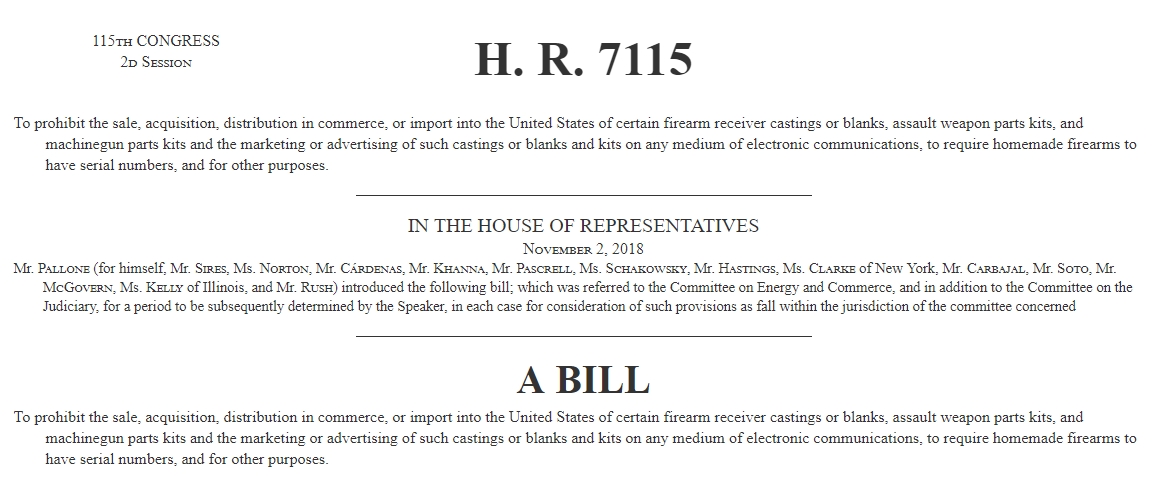H.R. 7115 Proves Anti-Gunners’ Tactics Have Shifted
House Democrats appear to be a little drunk on their recent return to majority status in the south wing of Congress. Having turned the chamber just one fortnight ago, current Democrats, led by Frank Pallone, Jr. (D-NJ), were quick to introduce what they’ve dubbed the 3D Firearms Prohibition Act. As you’ll see in a moment, the bill’s title does a poor job of defining the scope of the proposal, and despite its extremely low chances of passage, H.R. 7115 should be all the motivation gun owners need to spring into action.
It’s critical to get something out of the way – the current rendition of the 3D Firearms Prohibition Act stands practically no chance of ever becoming law. This Congress (115) will give way to the 116th Congress in January. At that point, the board is cleared, and any pending legislation that has yet to pass must be reintroduced or otherwise left in the garbage heap. Republicans are unlikely to spend their last two months as the majority trying to push H.R. 7115 along, and the Senate is wisely more interested in focusing on judicial nominees than anything else. Even after January, a new bill faces an uphill battle because it would still need to clear a Republican Senate. That doesn’t mean any of us need to be complacent.
Digging into the meat of H.R. 7115, it’s immediately apparent that this bill is far more than a piece of 3D-printed gun legislation. It’s barely that at all. I’ve spilled loads of virtual ink on the junction of 3D printing and firearms, and the one point I’ve always emphasized is that it’s currently impossible for 99.9% of people to fully 3D-print a functional firearm at home. Garage hobbyists rely on non-printed parts to make up key components of “3D-printed” builds.
The three main sections of the surprisingly brief bill can be summarized as follows:
- Bans parts kits for semi-automatic rifles, machineguns, and prohibits the sale of any receiver blank or casting that upon completion can be installed on most semi-automatic rifles, machineguns, or handguns.
- Bans advertising for the items listed in the above section.
- Requires home-built firearms to carry a serial number issued by a licensed dealer and reported as a transfer within the licensee’s bound book, requiring a NICS background check and completion of a Form 4473.
Notably, H.R. 7115 doesn’t specifically address 3D printed firearms. There’s a bit in the serial number section that mentions how plastic receivers must contain 17-4 stainless inserts upon which the serial number is to be applied. It’s clear that Democrats are looking to capitalize on the recent media panic surrounding these mostly-experimental arms to deal a massive – and arguably vengeful – blow against all types of ballistic DIYers. Because let’s be very clear, homemade firearms are relatively uncommon features at crime scenes, and the sort of person with the capability and know-how to manufacture a gun with criminal intent is hardly going to be moved by this sudden effort to ban homebuilt firearms.
The bans on kit and receiver sales and advertisements are alarming by themselves, but both are self-explanatory. They’re also rather toothless in the sense that, at least as far as I can tell, neither prohibits the individual sale of parts that could otherwise make up a “parts kit.” The details of the serial numbering scheme are where H.R. 7115 is most troubling. The bill states that no more than 90 days after serial number issuance, the maker must present the completed firearm to the dealer who issued the number for inspection and verification. So that means that homebuilders have 90 days to build their gun, right? Not so much. See, the section also establishes that the requested serial number must be applied to the firearm’s receiver within ten days of issuance. Realistically, this means that builders must machine their firearm’s receiver within those first ten days and the rest of the firearm must be complete no more than 80 days later. Finally, H.R. 7115 classifies as “assault weapons” all semi-automatic rifles with detachable magazines – the broadest definition offered to date.
As I noted earlier in this piece, H.R. 7115 stands very little chance of becoming law – at least for now – but that doesn’t excuse inaction. After Democrats flipped the House of Representatives in this month’s midterm elections, Republican’s firewall against Second Amendment infringements has been reduced to President Trump and a slim (but slightly expanded) majority in the Senate. A new H.R. 7115 is likely to surface at the beginning of the new session, and for that reason, it’s worthwhile to contact current and soon-to-be members of Congress.
An information security professional by day and gun blogger by night, Nathan started his firearms journey at 16 years old as a collector of C&R rifles. These days, you’re likely to find him shooting something a bit more modern – and usually equipped with a suppressor – but his passion for firearms with military heritage has never waned. Over the last five years, Nathan has written about a variety of firearms topics, including Second Amendment politics and gun and gear reviews. When he isn’t shooting or writing, Nathan nerds out over computers, 3D printing, and Star Wars.

